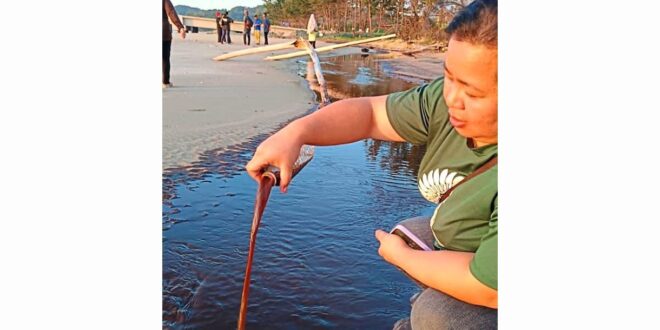KOTA KINABALU: The Sabah Environment Protection Department (EPD) should make public the environmental impact assessment (EIA) reports for the RM2bil silica sand mining operation in northern Kudat district.
Indigenous rights activist Adrian Lasimbang said various NGOs as well as residents from the five villages affected by the project had been asking for the reports.
“We want to see if our concerns were included in the reports and if the conditions given by the NGOs were fulfilled by the company,” said Lasimbang, who is Sabah Native Voices Organisation president.
“The villagers are anxious because they are facing many concerns about the project, such as not having access to the Bangau beach,” he said when contacted.
Then and now: A satellite image of Bangau Beach from 2020 showing no stream of dark water flowing into the sea, compared to a 2023 satellite image of the beach showing the stream of dark water next to the jetty. — Photo courtesy of Adrian Lasimbang
He said these villagers were not disputing about the land because it was privately owned but they were concerned they might not have access to the beach anymore.
“They used to fish and search for mollusks and crabs but when you fence off the access, then they are worried.
“This is a foraging area and indigenous people have the right to use is under their customary rights,” he said.
Lasimbang suggested that the reports be made accessible on the EPD website.
“The department should hold a meeting with the villagers on the EIA review for better transparency,” he added.
In August 2022, residents from five villages in Sikuati, about 14.5km from Kudat town, held a protest to voice their concerns about the silica sand mining and processing project
The residents from Kampung Bangau, Andab Bangau, Andab Darat, Kimihang and Longgom Kecil were worried about the environmental impact on the idyllic Bangau beach as well as the surrounding areas.
Kudat district is about 130km from here.
In June last year, EPD director Vitalis Moduying said the processing plant had started construction and that every phase of the project was being assessed.
He said four EIA reports had been presented to the department, two for the processing plant at Kota Kinabalu Industrial Park and two for the Sikuati mining site.
The developers have complied with all regulatory requirements then, he said.
Last year, Sabah Industrial Development and Entrepreneurship Minister Datuk Phoong Jin Zhe had also said that all environmental concerns raised by villagers about the project, to be carried out by a China-based group, have been recorded in the EIA study.
Lasimbang, however, said the villagers were still troubled over the development near the beach and their villages.
He said NGOs under the Indigenous People Network Malaysia found out about their concerns during a visit to the beach and in a dialogue with the villagers during a fact-finding mission on Feb 10.
“The villagers are worried about a stream that has emerged, with dark water flowing into the beach.”
He noted that there had been a previous explanation by the Sabah Environmental Protection Association that the water was not polluted.
“But for me, open discharge to the sea, even if there is no toxin, especially when it is an unnatural flow, can still affect the ecosystem,” Lasimbang said.
He said that satellite images of the beach from 2006 to 2020 showed the stream of dark water was not there but a 2023 image indicated it had already emerged.
Another concern, he said, was whether the EIAs on the mining and operation took into account that Bangau beach was part of the marine biodiversity rich Tun Mustapha Park.
“This is a Totally Protected Area, so the effects from the project must be accounted for,” he said.
 BeritaKini.biz Berita Viral Terkini di Malaysia
BeritaKini.biz Berita Viral Terkini di Malaysia





